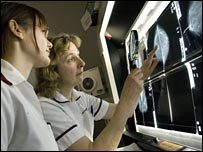Radiologists' Requests for Follow-Up Exams Doubled in the Last Decade
by
Brendon Nafziger, DOTmed News Associate Editor | November 03, 2009

Radiologists are ordering
significantly more studies
Twice as many radiological exams prompt follow-up studies as they did a decade ago, according to an article out this month in Radiology.
Working with a specialized computer algorithm, doctors at Massachusetts General Hospital in Boston, led by Christopher Sistrom, M.D., sifted through nearly six million radiological exams from 1995 to 2008. The algorithm, using natural language processing, a technique that converts human language into material a computer can easily quantify, allowed the researchers to process vast amounts of data.
The results suggest a boom in recommendations for additional imaging (RAIs) over the last 13 years, with the number of exams calling for a follow-up study rising from 6 percent to 12 percent.
Some of the findings fell in line with predictions: the region of the body most likely to spur an RAI was the chest, especially the breast, and examinations with positive findings had around five times the odds of seeking a follow up as ones with negative findings. Outpatients, or those coming from the emergency room, were also more likely to get follow-up imaging.
Intriguingly, the more experienced the radiologists, the less likely they were to request a follow-up exam. The odds for ordering an RAI dropped by around 15 percent per decade of experience.
"The initial reaction to this finding was that radiologists improve their accuracy and confidence as they build their experience base and gain more knowledge through continuing education," Ronald Arenson, M.D., a radiologist at the University of California, San Francisco, writes in an editorial that accompanies the article. "But is there another possible explanation? Perhaps the younger radiologists are more familiar with newer modalities and imaging techniques and know of other procedures that could shed more light on the particular problem."
In any case, statistical analysis suggests the doubling of RAIs does not come from the rise in junior radiologists reading exams.
Then what is causing the increase? Dr. Sistrom and his co-authors don't know yet, but in the paper they suggest everything from the greater sophistication of imaging equipment and software that allows detection of fainter lesions, which would then need further investigation, to the growing menace of malpractice suits.
It's also possible that a handful of "eager" radiologists are responsible for the bulk of extra imaging, something the researchers hope to tease apart from the data with future studies.
"The next step is to use the model we developed to come up with case-mix-adjusted expectations of how many RAIs a given radiologist would have if they behaved like the average of all peers and compare with their actual [rates] to get an observed/expected ratio," Dr. Sistrom tells DOTmed News by email.
